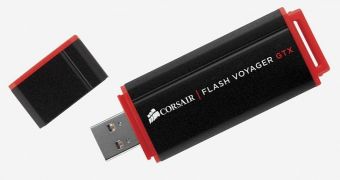While companies like Kingmax are teasing us by withholding the best of the newest storage technologies until later, Corsair is offering the best possible examples of one of the oldest types of external storage devices: the flash drive.
The company has just launched the Flash Voyager GTX USB 3.0 line of small, stick-like, virtual file holders, and not only gave them a lot of space, but the best performance as well.
Some may try to contest the latter claim, but they would have a tough time proving that any flash drive on the market is better at reading or writing data than this one.
After all, the Corsair Flash Voyager GTX USB 3.0 devices reach read/write rates well beyond those of many SATA III (SATA 6.0 Gbps) SSDs, and definitely leagues ahead than any SATA HDD. All this made doubly remarkable by the fact that the USB 3.0 technology has a top throughput of 5 Gbps (4.8 Gbps if you want to get technical).
Long story short, the Corsair Flash Voyager GTX USB 3.0 flash drives come in 256 GB and 128 GB capacities and can read at 400 MB/s, while writing is accomplished at 350 MB/s.
Admittedly, most of the SSDs we write about tend to have data rates in the 500 – 550 MB/s range, but the truth is that the high-end ones that catch our eye are the ones that sell the least, being as expensive as they are. The “real” consumer SSDs stick to 200-400 MB/s, and sometimes even less.
Between that and the natural disadvantage that USB 3.0 has (as mentioned above), it is safe to say that the Corsair Flash Voyager GTX USB 3.0 flash drives are remarkable indeed. It is a real irony that, like the best of the SSD market, they won't sell very well, not with the prices they have: $120 / €120 (no matter what exchange rates say) for the 128 GB model, and $240 / €240 for the 256 GB one.
Both devices use USB Attached SCSI and S.M.A.R.T. Monitoring technologies (fast, error-free transfers of even the largest videos and file collections), have TRIM support (clear out erased files to free deleted sectors and write cycles, thus maintaining performance over time), and are compatible with Microsoft Windows, Mac OS X, and Linux.
One might go so far as to say that they are solid state drives in flash drive form. After all, TRIM started out as an SSD-exclusive capability, and flash drives don't usually come in the capacities these things do.

 14 DAY TRIAL //
14 DAY TRIAL //